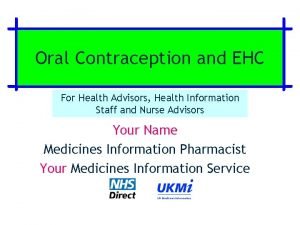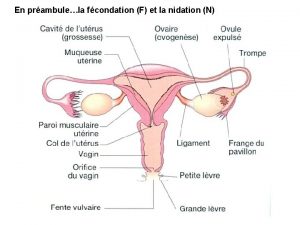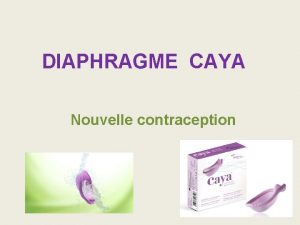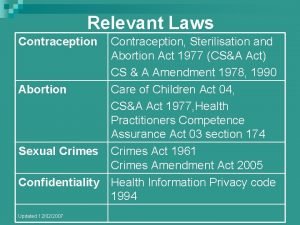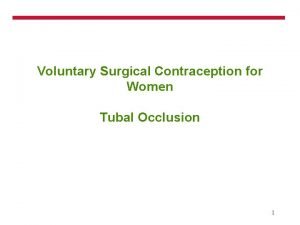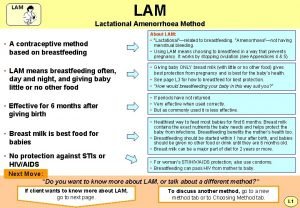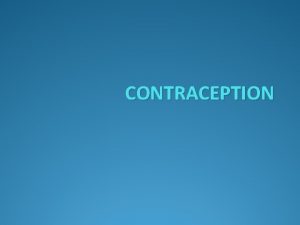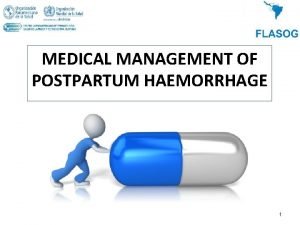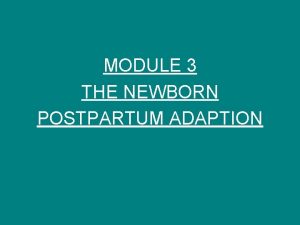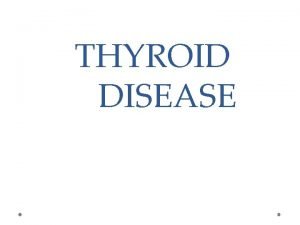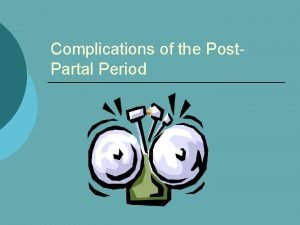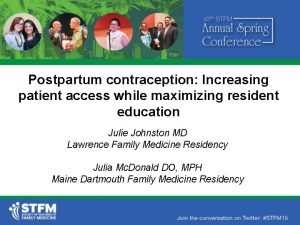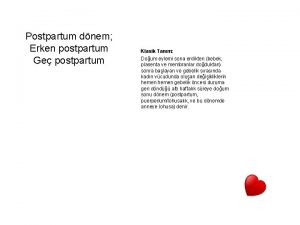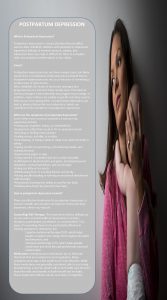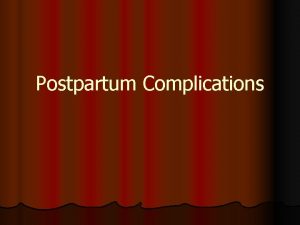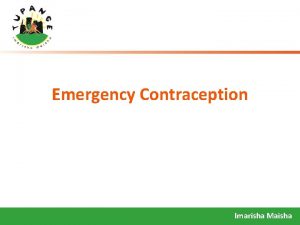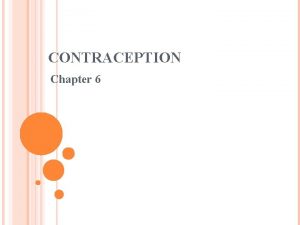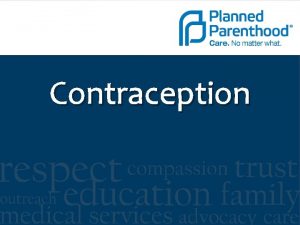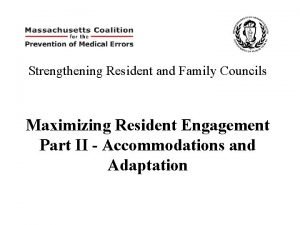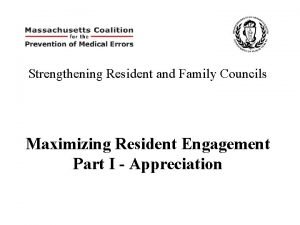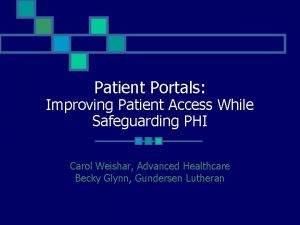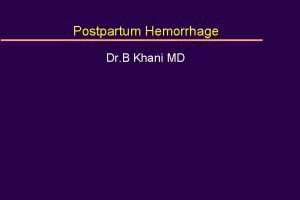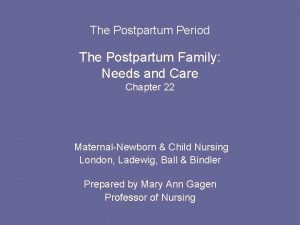Postpartum contraception Increasing patient access while maximizing resident
















- Slides: 16

Postpartum contraception: Increasing patient access while maximizing resident education Julie Johnston MD Lawrence Family Medicine Residency Julia Mc. Donald DO, MPH Maine Dartmouth Family Medicine Residency

Disclosures Dr. Johnston • Merck – Nexplanon faculty trainer – Spouse with stock holdings • Johnson and Johnson – Spouse with stock holdings Dr. Mc. Donald-Nothing to disclose

Objectives Upon completion of this session, participants should be able to: 1. Identify safe and effective immediate postpartum contraceptive methods. 2. Name one barrier in your health setting that inhibits immediate postpartum contraceptive provision. 3. Develop a strategy for improving access to postpartum contraception through resident involvement.

Why the rush for postpartum contraception? • The U. S. has the highest rate of unintended pregnancy of any developed country ~ 50% • Nationwide 10 -40% miss the postpartum (PP) visit • <50% women who desire an IUD PP receive it • Infant spacing is important for maternal and child health • Unintended rate is 10% in the first year PP • Non-breastfeeding women return to ovulation in 45 days • Most women resume sexual intercourse prior to their PP visit

Contraception and US Medical Eligibility Criteria (MEC) <1 month Postpartum Breastfeeding Not Breastfeeding Progestin only pills 2 1 Depo 2 1 Levonorgestrel IUD* 2 2 Paragard IUD* 1 1 Etonogestrel 2 1 *<10 minutes after delivery of the placenta

U. S. Selected Practice Recommendations for Contraceptive Use, 2013 • Guidelines reflect the U. S. Medical Eligibility Criteria for immediate placement of IUDs and Implants postpartum

Women’s interest in IPP IUDs • Women may be more motivated in the immediate post-partum period to start contraception. • Women who agree to IPP placement are more than 10 x more likely to have the IUD inserted than those women who decided to wait until the post-partum visit Mohamed S. , Kamel, M. , Shaban O. , Salem, H. Acceptability for the use of postpartum intrauterine contraceptive devices: Assuit experience. Med Princ. Pract 2003; 12: 170 -5.

Etonogestrel and Breastfeeding • 40 exclusive breastfeeding moms • Randomized to ETG 24 -48 hr after delivery or Depo at 6 weeks • Outcome: • ETG had larger maternal weight loss • ETG had increased infant weight gain Brito, M. , Ferriani, R. , et al. Safety of the etonogestrel-releasing implant during the immediate postpartum period: a pilot study. Contraception. 2009; 80: 519 -526.

Postplacental IUDs • Placed within 30 minutes of a vaginal placental delivery or during a c-section • Post-placental IUD placement does not increase the risk of endometritis Welkovic, S. , et al. • Post-placental IUD placement does not increase the risk of excessive bleeding Welkovic, S. , et al. • IPP expulsions are higher but total pregnancies at 1 yr were not (3. 1% overall IPP and INT) K. Eroglu et al. – 6 -19% after vaginal birth, 12. 1% is often quoted – 1. 2 -9. 6% after c-section • IUDs can be replaced if expelled

What we did in Lawrence, MA • 2013: Initiated in-hospital post-partum ETG implant placement. • HOW: If ETG implant desired, ordered in EMR (device billed through GLFHC 403 b pharmacy), delivered to LGH pharmacy for verification, then brought to floor for (unbilled) placement. • Multiple benefits: — In women with ante partum stated intention to use, receipt of device (w/i 6 wks PP) INCREASED from 26. 5% to 93. 5% — Increased procedural numbers for residents — Communication between residents and staff (RN, lactation)

Resident Procedures: ETG • 3/12 -3/14 – Insertions: 31 – Removals: 15 • 3/14 -3/15 – Insertions: 189 – Removals: 54

LARC Funding Programs • RHEDI • Get LARC Now • Ryan (OB/GYN programs)

• • • Medicaid Coverage Alabama Colorado (+/-) Georgia Iowa Louisiana Maryland • • • Montana New Mexico New York Oklahoma South Carolina http: //www. acog. org/About-ACOG/ACOG-Departments/Long-Acting-Reversible. Contraception/Coding-and-Reimbursement-for-LARC/Reimbursement-Resources-for. Postpartum-LARC-Initiation/Medicaid-Reimbursement-for-Postpartum-LARC-By-State

Contacts • Alicia Luchowski at the ACOG LARC Program: ALuchowski@acog. org

• • • • References Celen, S. , Moroy, P. , Sucak, A. , Aktulay, A. , Danisman, N. Clinical outcomes of early postplacental insertion of intrauterine contraceptive devices. Contraception 2004; 69 279 -82. Chi, I. , Wilkens, L. , Rogers, S. Expulsions in Immediate Postpartum Insertions of Lippes Loop D and Copper T IUDs and their Counterpart Delta Devices-An epidemiological Analysis Contraception 1985 Aug; 32(2): 119 -134. Grimes, D. A. , Schulz, KF. , Van Vliet, HHAAM, Stanwood, NL. , Lopez, LM. Immediate post-partum insertion of intrauterine devices (Review). Cochrane Collaboration 2008 (3). J. L. Hayes et al. A pilot clinical trial of ultrasound-guided postplacental insertion of a levonorgestrel intrauterine device. Contraception 2007 Oct; 76(4): 292 -6. Welkovic, S. , et al. Post-partum bleeding and infection after post-placental IUD insertion. Contraception 2001; 63: 155 -9. K Eroglu et al. Comparison of efficacy and complications of IUD insertion in immediate postplacental/early post partum period with interval period: I year follow-up. Contraception 2006; 74(5): 376 -81. Mohamed S. , Kamel, M. , Shaban O. , Salem, H. Acceptability for the use of postpartum intrauterine contraceptive devices: Assuit experience. Med Princ. Pract 2003; 12: 170 -5. Muller, A. , et al. Transvaginal ultrasonographic assessment of the expulsion rate of intrauterine devices inserted in the immediate postpartum period: a pilot study. Contraception 2005; 72: 192 -195. Gurtcheff, S, MS; Turok, D. , et. al. Lactogenesis After Early Postpartum Use of the Contraceptive Implant: A Randomized Controlled Trial. Obstetrics and Gynecology 2011; 117: 1114 -1121. Kapp N, Curtis K, Nanda K. Progestogen-only contraceptive use among breastfeeding women: a systematic review. Contraception 2010; 82: 17– 37. Chen, B. , Reeves, M. Postplacental or delayed levonorgestrel intrauterine device insertion and breastfeeding duration. Contraception. 2011; 84(5): 499 -504. Stevermer, J. , Jones, K. , Egan, M. Offer this contraceptive to breastfeeding new moms. J Fam Pract. 2011; 60(12): 744 -746. Brito, M. , Ferriani, R. , et al. Safety of the etonogestrel-releasing implant during the immediate postpartum period: a pilot study. Contraception. 2009; 80: 519 -526.

Please evaluate this session at: stfm. org/sessionevaluation
 Contraception
Contraception Nidation
Nidation Victorian era condoms
Victorian era condoms Diaphragme contraception caya
Diaphragme contraception caya Contraception sterilisation and abortion act 1977
Contraception sterilisation and abortion act 1977 Diaporama sur la contraception
Diaporama sur la contraception Voluntary surgical contraception
Voluntary surgical contraception Contraception for over 40s
Contraception for over 40s Lactational amenorrhea
Lactational amenorrhea Ogn and pgn full form in contraception
Ogn and pgn full form in contraception Patient 2 patient
Patient 2 patient Do while loop adalah
Do while loop adalah Oxytoxics
Oxytoxics Bubble postpartum
Bubble postpartum Postpartum infections
Postpartum infections Postpartum thyroiditis
Postpartum thyroiditis Lochia smell
Lochia smell
